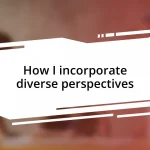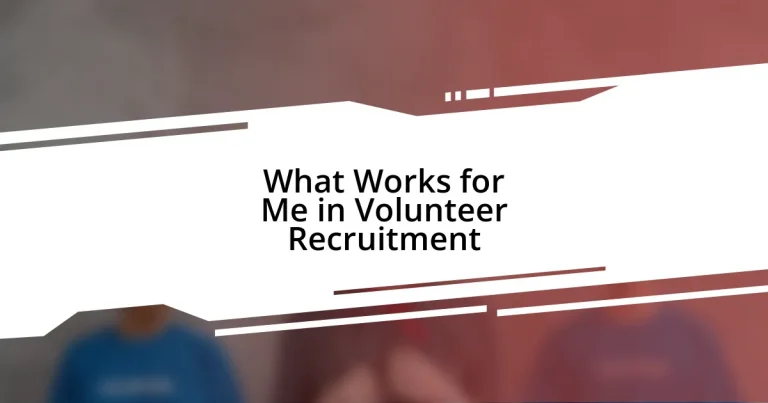Key takeaways:
- Understanding the motivations of potential volunteers and creating personal connections can significantly enhance recruitment efforts.
- Identifying target demographics and tailoring outreach strategies according to age, interests, location, skills, and motivations is crucial for effective volunteer recruitment.
- Using social media platforms to share compelling stories and visuals can amplify recruitment efforts and attract more volunteers.
- Implementing effective onboarding processes and maintaining open communication with volunteers fosters long-term commitment and engagement.
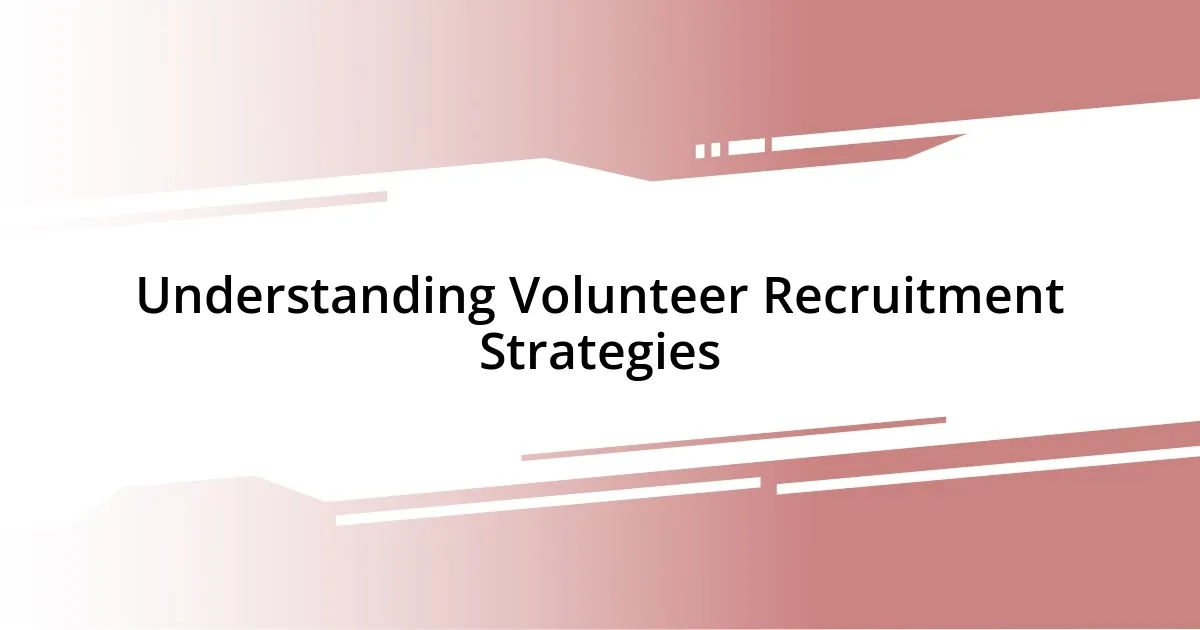
Understanding Volunteer Recruitment Strategies
When I think about volunteer recruitment strategies, I often reflect on my early experiences in organizing community events. I learned that understanding the motivations of potential volunteers can make a significant difference. For instance, asking yourself, “What drives people to give their time?” can lead you to tailor your outreach efforts more effectively.
One approach I’ve found particularly effective is leveraging personal stories in my communication. When I share how volunteering transformed my life or the impact it had on my community, I see a spark of interest ignite in others. It’s remarkable how a simple narrative can resonate powerfully and inspire people to step forward and contribute their time and skills.
Moreover, creating a welcoming atmosphere during recruitment events is crucial. I’ve noticed that when I take the time to interact personally, smiling and engaging with each volunteer prospect, their anxiety about joining a new cause diminishes. Have you ever felt more inclined to join a group when the environment felt warm and inviting? Building a genuine connection goes a long way in making volunteers feel valued right from the start.
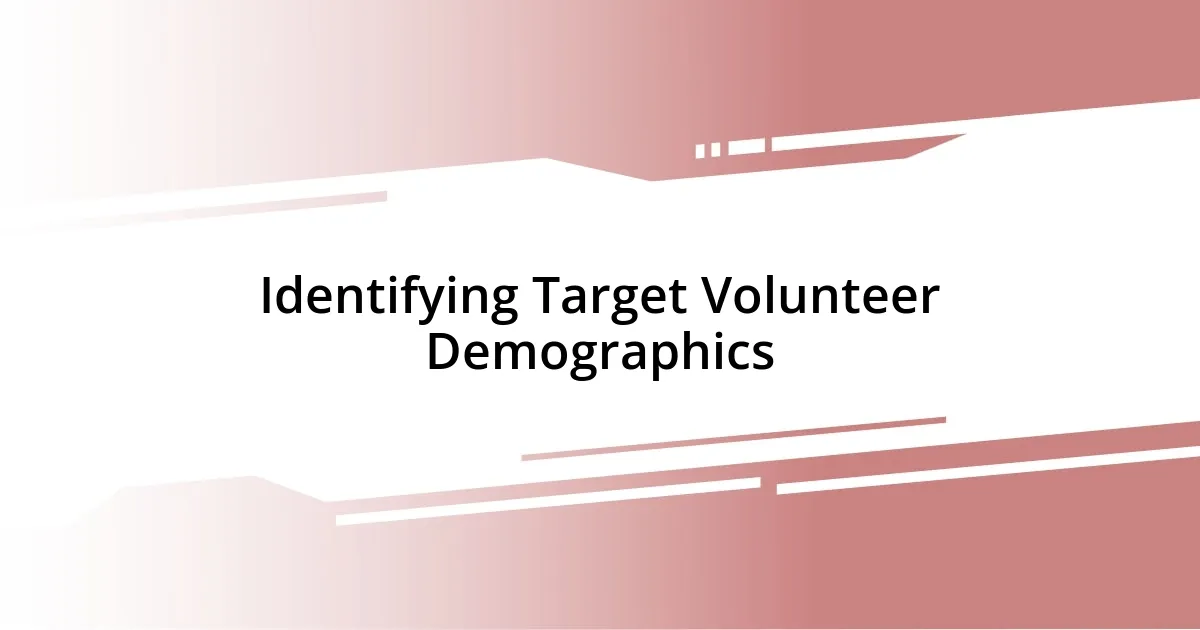
Identifying Target Volunteer Demographics
Understanding who your potential volunteers are is essential for effective recruitment. I remember when I organized a local cleanup event; I made the mistake of not considering the demographics of my community. After realizing that students were mostly available on weekends, I adjusted the timing and communicated it through places where students gathered, like cafes and universities. This shift sparked a significant increase in participation.
To identify your target volunteer demographics effectively, consider the following aspects:
- Age Group: Are you aiming for younger individuals, families, or seniors? Each group has different availability and motivations.
- Interests: Understand the causes that resonate with your audience. Do they care about environmental issues, social justice, or education?
- Location: Are your potential volunteers local residents, or do you have a broader reach? Tailoring your outreach based on proximity can be very effective.
- Skills: What unique skills can your volunteers bring? Knowing this helps in creating roles that align with their strengths.
- Motivations: What drives them? Are they looking to expand their network, gain experience, or simply give back to the community? Recognizing these motivations can enhance your communication strategies.

Crafting Compelling Volunteer Opportunities
Crafting the right volunteer opportunities involves more than just listing tasks. In my experience, it’s about understanding the unique skills and availability that potential volunteers bring to the table. For example, when I first started organizing a mentorship program, I mistakenly offered vague roles without considering what individuals truly wanted. After reaching out for feedback, I tailored responsibilities to fit their interests, and the enthusiasm was palpable. When people see how their strengths can shine, they’re much more likely to commit.
Next, I’ve found that creating clear, engaging descriptions can really attract volunteers. Take the time to highlight not just what they’ll be doing, but also the meaningful impact their role will have. I remember crafting a project description that emphasized how volunteers would directly contribute to improving literacy rates among children. The response was overwhelmingly positive! It’s incredible how a small tweak in communication can showcase the value of the opportunity and entice more people to sign up.
Additionally, flexibility in volunteer roles can make a vast difference. For instance, one project I worked on included a variety of shifts and tasks, which encouraged more people to participate. I once met a nurse who was interested in helping but could only commit a couple of hours during her busy schedule. By offering her a short but impactful role, she joined our team happily. It just goes to show that when volunteers feel they can contribute in a way that fits their life, everyone benefits.
| Factor | Importance |
|---|---|
| Understanding Skills | Enhances role alignment |
| Engaging Descriptions | Increases interest and participation |
| Flexibility in Roles | Accommodates diverse schedules |

Utilizing Social Media for Recruitment
Leveraging social media for volunteer recruitment has been one of my best strategies. I started by creating a dedicated Facebook page for our community initiatives, where I could share engaging visuals and stories about past events. I noticed that when I highlighted personal experiences of volunteers, it sparked interest among our friends and family networks. Does it ever surprise you how a heartfelt story can create a ripple effect?
Another thing I’ve discovered is the power of local community groups on platforms like Nextdoor or Facebook. I posted simple yet eye-catching calls for volunteers, including photos from our last event, which really brought the message home. The interactions that followed were incredible; people not only expressed interest, but many also shared the post in their circles. I genuinely felt a sense of community we hadn’t tapped into before.
Instagram has also proven to be invaluable. I remember posting a short reel showcasing our volunteer day, capturing the smiles and energy of everyone involved. In the comments, not only did we get inquiries from potential volunteers, but we also built connections with local businesses wanting to support us. It’s fascinating how tapping into the visual appeal of social media can inspire action. Are you ready to harness that potential?
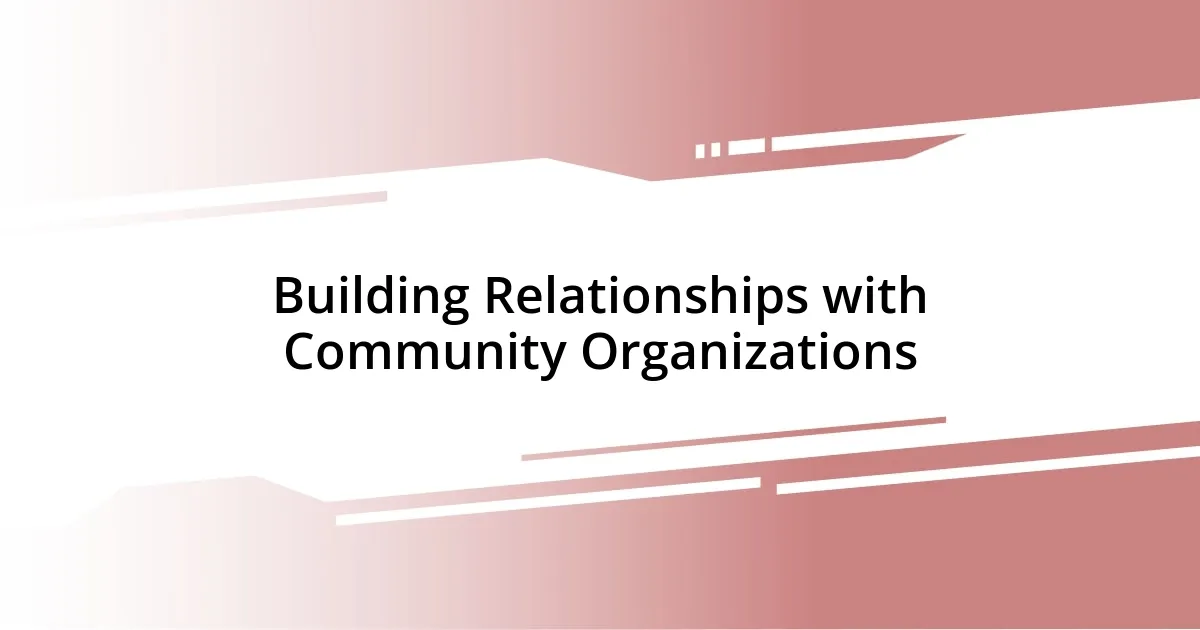
Building Relationships with Community Organizations
Building strong relationships with community organizations is essential for successful volunteer recruitment. I’ve found that reaching out to local nonprofits and clubs establishes a foundation of trust and collaboration. During one of my initial outreach efforts, I met with the director of a nearby youth center. Our conversation revealed common goals, and we left with a mutual understanding of how our organizations could support one another. It was eye-opening to see how a simple coffee chat could pave the way for a fruitful partnership. Have you ever considered how those face-to-face interactions can transform your outreach strategy?
I also discovered the importance of listening actively. When I collaborated with a local environmental group, I made sure to understand their specific needs and challenges. This rapport led to brainstorming sessions where we not only shared our resources but pooled ideas for joint volunteer events. As a result, we increased volunteer engagement significantly. There’s something powerful about merging efforts; it makes you realize that working together amplifies your impact in the community. Isn’t it fascinating how collaboration can create such a ripple effect?
Regular follow-ups and check-ins with these organizations have proven invaluable as well. After formulating plans, I made a habit of reaching out to see how things were progressing. For instance, after organizing a joint event, I called to gather feedback. This made the director feel valued, and it opened the door to new opportunities. Maintaining open lines of communication can elevate your partnership to new heights and ensures everyone is still aligned on shared goals. Wouldn’t you agree that fostering these relationships can unlock endless possibilities for your volunteer initiatives?
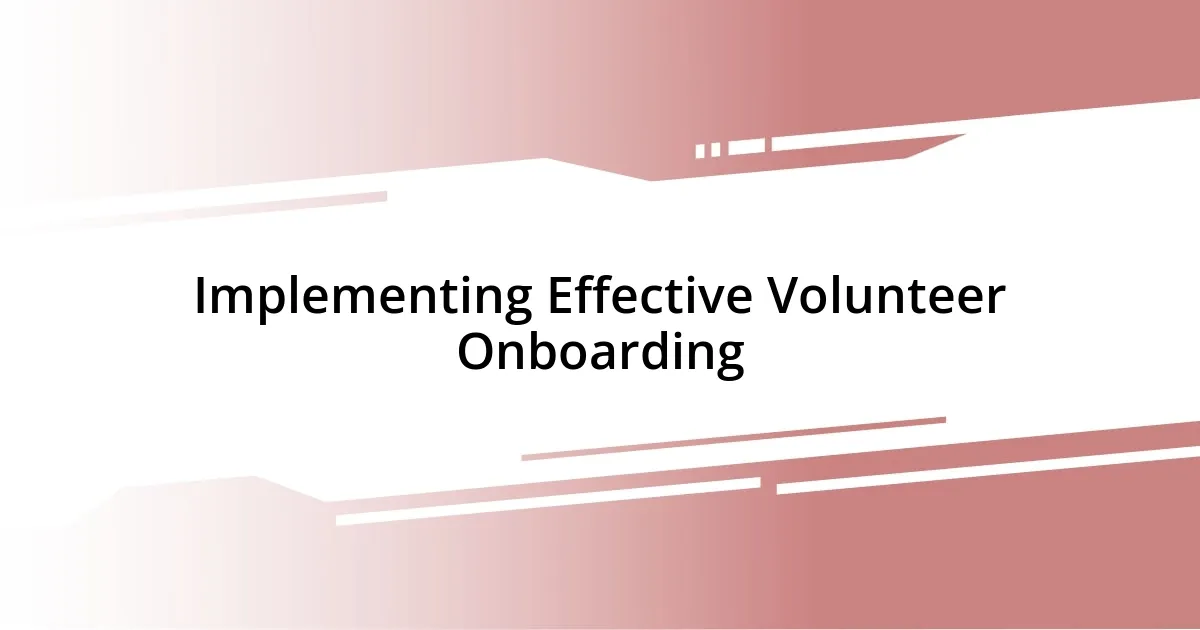
Implementing Effective Volunteer Onboarding
Implementing effective volunteer onboarding is crucial for turning enthusiasm into actionable commitment. I once experienced a situation where a new volunteer, excited yet overwhelmed, joined our team without clear guidance. It struck me how essential it is to walk them through the onboarding process, ensuring they feel welcome and informed. Have you ever thought about how a simple orientation could significantly impact a volunteer’s experience?
I’ve learned that personal touches during onboarding can make all the difference. For instance, I always host a casual meet-and-greet where new volunteers can connect with seasoned team members. What’s remarkable is the bonding that happens — sharing past experiences and expectations not only eases nerves but also fosters a sense of belonging. Remember the last time you felt part of something bigger? That sense of community is exactly what I aim to create.
Furthermore, I discovered the importance of ongoing training and support. After a recent event, I followed up with new volunteers to gather their feedback and answer any lingering questions. This practice not only helped them feel valued but also encouraged them to share their insights on what could be improved. I’ve seen firsthand how these discussions not only enhance the onboarding experience but also contribute to building a stronger, more engaged team. Isn’t it amazing how nurturing these relationships can lead to long-term dedication?

Measuring Success in Volunteer Recruitment
Measuring success in volunteer recruitment can be tricky, but I focus on a few key metrics that truly matter. One of the most telling signs of success I’ve encountered is volunteer retention rates. For instance, after implementing a targeted engagement strategy, I noticed a surprising increase in volunteers who returned for multiple events. It made me realize that enthusiastic volunteers are often the result of meaningful connections and positive experiences. How do you currently track your volunteer retention?
I’ve also learned the importance of gathering feedback from volunteers mid-project. I remember during a large community clean-up, I took a moment to pause and ask participants for their thoughts on the experience. Their insights not only highlighted areas for improvement but also affirmed what was working well. It was a humbling experience to realize that involving volunteers in the conversation helps foster a deeper sense of ownership. Isn’t it remarkable how simply asking can lead to more engaged volunteers?
Quantifying impact is another essential aspect I prioritize. For example, I tracked the number of community members reached through volunteer efforts and how many projects were completed. Seeing the numbers climb has been incredibly motivating for both me and the volunteers. I’ve found that sharing these successes creates a potent motivation loop, igniting passion in future recruitment efforts. What metrics do you consider vital to measure your impact?
